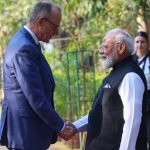India Then and Now
Text: Rudrangshu Mukherjee and Vir Sanghvi
Photo research and editing: Pramod Kapoor
Publisher: Lustre Press / Roli Books
Pages: 276 • Price: Rs.2975/-
By Manish Chand
Hip-shaking dancers on a glitzy Bollywood set, shy Muslim women peering through their veils, beautiful people playing polo and villagers enjoying bullock cart races – they are just some of the stunning and contrasting images of contemporary India showcased in this lavishly produced coffee-table book.
Clearly, it is an ambitious task for such a book to chronicle the life of a country as diverse and multi-layered as India, but this elegantly produced book and its thoughtful collection of photographs do manage to convey some of the energy that keeps this country of one billion-plus people ticking.
As opposed to these visual treats that form the “India Now,” section, introduced by celebrity journalist Vir Sanghvi, there are a string of black and white sepia photographs that take the readers back to the era before independence, giving an insight into the defining moments of India.
If the “India Now” section abounds in vibrant and colourful photographs capturing the mood of a robust nation, the “India Then” section, introduced by veteran journalist Rudrangshu Mukherjee, connects readers with some of the deeper civilisational undercurrents that imbue Indians with a sense of distinct national identity.
But there’s no clear demarcation between the India of ‘then’ and ‘now’. Or could it be that it is impossible to dissociate the present from the past – what poet T.S. Eliot has called “the presence of the past.”
Publisher Pramod Kapoor has clearly benefited from “providence that comes with perseverance in photo-editing” – and it shows in these diverse photographs culled from contemporary practitioners and canonical names like Felice A. Beato, Samuel Bourne and Lala Deen Dayal.
There are some rare photographs like that of American sculptor Jo Davidson giving finishing touches to a bust of Mahatma Gandhi in 1931 with the father of the nation posing for it.
And then there are haunting images like the ones showing priests praying for peace and harmony in the aftermath of communal riots linked to partition and drought-hit farmers praying for rain.
Needless to say pictures are the soul and substance of the book. The commentaries accompanying both the sections, given the limitations of the coffee-book genre, are however rather glib and tend to simplify complex truths about this country that has been the victim of an image trap.
Sanghvi does a fine job of capturing “a sense of great optimism” that has seized the post-liberalisation period in India. Some skeptics may snigger at such feel-good India sentiments and point to the other India that is still shackled to illiteracy and poverty and lacks basic infrastructure of civilised life.
Despite these problems, Sanghvi finds it hard to be pessimistic about India. “Despite our problems and our missed opportunities, there is a sense that not only the slumbering elephant has finally awakened, but that it is moving forward,” writes Sanghvi.
Author Profile

- Manish Chand is Founder and Editor-in-Chief of India Writes Network (www.indiawrites.org) and India and World, a pioneering magazine focused on international affairs. He is CEO, Centre for Global India Insights, an India-based think tank focused on global affairs.
Latest entries
 India and the WorldJanuary 13, 2026India, Germany raise the bar for defence, economic ties
India and the WorldJanuary 13, 2026India, Germany raise the bar for defence, economic ties India and the WorldDecember 12, 2025India-Italy bonding: Tajani’s visit raises the bar for business, maritime ties
India and the WorldDecember 12, 2025India-Italy bonding: Tajani’s visit raises the bar for business, maritime ties In ConversationNovember 26, 2025G20 is a Force for global Good
In ConversationNovember 26, 2025G20 is a Force for global Good articlesNovember 26, 2025Rescuing G20 from North-South divide: Ubuntu Moment
articlesNovember 26, 2025Rescuing G20 from North-South divide: Ubuntu Moment






